tim.rose2
Active member
I'm hoping there's a suitably knowledgeable person out there who can give me an explanation for the array of colours seen in the formations on Portland? I have a chemistry background so looking for some science here - i.e. what minerals / elements cause these and where they've come from (presumably the soil above?). What sort of concentrations / co-crystal structures etc. exist? What's the mechanism for transport / deposition (presumable dissolution / precipitation from water similar to CaCO3 driven by pH change?) The islands caves are often described as void of formations, but if you know where to look this is far from the truth. We've also just found another ton of the stuff so it's perked my interest.
A few observations which may or may not influence the colours...
1. The majority of the flowstone is found in rifts in the higher limestone beds (freestone). Very little in the lower cherty series. There is less flowstone in the phreatics but again where it exists most is in the higher level tunnels in the freestone.
2. The vertical distance from roof of decorated rifts to ground level above is usually only a few metres (3 to 10 m). What soil there is on Portland is a very sticky clay. Much of the area above the caves is built on, quarried or peoples gardens.
3. The colours seen are cream, yellow, orange, red & grey (particularly interested in the grey colours as I've not seen this anywhere else). I've personally never seen a single bit of pure white calcite on Portland, though some of the cream coloured stal is nearly white but this is rare. Yellow / Orange is by far the most common.
4. Being an island surrounded in sea and since most of the cave entrances are on the cliffs there's no shortage of sea air (i.e. salt). No idea if this is relevant or not, however as salt premotes oxidation of iron and I've read somewhere iron (presumably the various iron oxides) causes red colours in stal I guess it might be.
5. Obviously Portland stone has been extensively quarried over the years as a building material, but I'm unaware of any mining for minerals and whilst being underground I've never noticed any mineral veins. I therefore don't think there's any significant mineralisation in the rock - well nothing valuable.
6. The caves are dry - There are some damp bits and some get a bit drippy when it's pi**ing down but there's no flowing water / streamways. There's only a few places where water forms small pools in the caves.
To give an idea of what I'm talking about here's some photos:
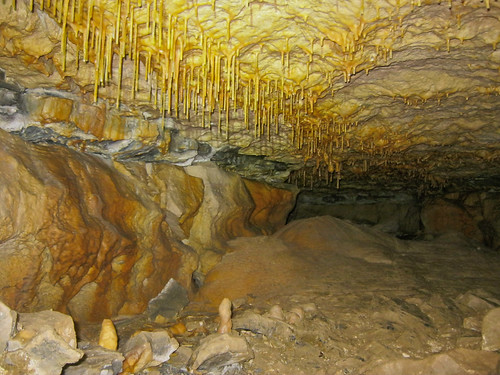
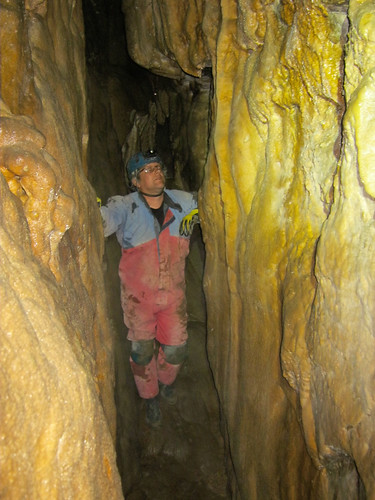
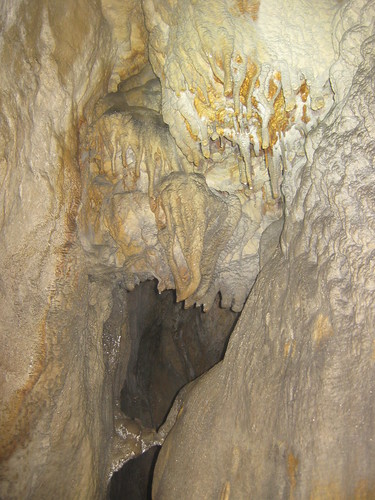








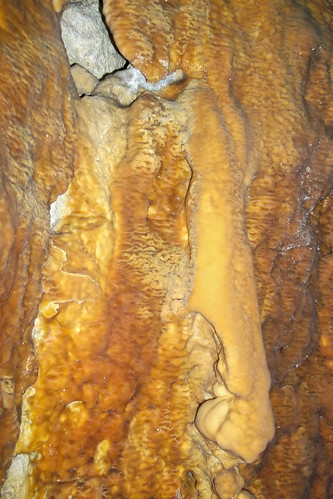



This one is actual bright yellow moon milk:




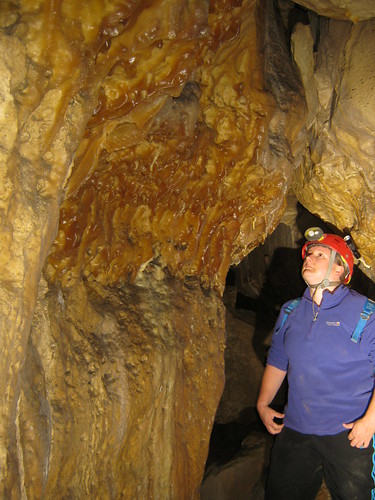
Well that turned into a bit of a photo splodge! Hopefully gives enough of an idea to start some discussion.
A few observations which may or may not influence the colours...
1. The majority of the flowstone is found in rifts in the higher limestone beds (freestone). Very little in the lower cherty series. There is less flowstone in the phreatics but again where it exists most is in the higher level tunnels in the freestone.
2. The vertical distance from roof of decorated rifts to ground level above is usually only a few metres (3 to 10 m). What soil there is on Portland is a very sticky clay. Much of the area above the caves is built on, quarried or peoples gardens.
3. The colours seen are cream, yellow, orange, red & grey (particularly interested in the grey colours as I've not seen this anywhere else). I've personally never seen a single bit of pure white calcite on Portland, though some of the cream coloured stal is nearly white but this is rare. Yellow / Orange is by far the most common.
4. Being an island surrounded in sea and since most of the cave entrances are on the cliffs there's no shortage of sea air (i.e. salt). No idea if this is relevant or not, however as salt premotes oxidation of iron and I've read somewhere iron (presumably the various iron oxides) causes red colours in stal I guess it might be.
5. Obviously Portland stone has been extensively quarried over the years as a building material, but I'm unaware of any mining for minerals and whilst being underground I've never noticed any mineral veins. I therefore don't think there's any significant mineralisation in the rock - well nothing valuable.
6. The caves are dry - There are some damp bits and some get a bit drippy when it's pi**ing down but there's no flowing water / streamways. There's only a few places where water forms small pools in the caves.
To give an idea of what I'm talking about here's some photos:















This one is actual bright yellow moon milk:





Well that turned into a bit of a photo splodge! Hopefully gives enough of an idea to start some discussion.


